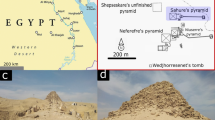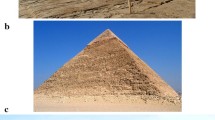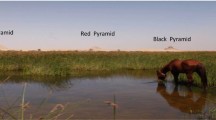Abstract
Step pyramid is the major archaeological unit of Djoser complex at Saqqara archaeological site. It is suffering now from various and serious deterioration and degradation features from various sources Rescue and Restoration studies of the first stone building ever witnessed i.e. pyramid of Djozer, Sakkara site, Egypt, included several aspects. Aspects under consideration in present study are concerned with geotechnical and geo environmental impacts on Djozer pyramid deterioration features of sub-surface units.
Main aspects dealt with are analysis of causes and sources of structural deterioration features of subsurface units of the pyramid itself such as galleries and entrances, burial shaft and its ceiling failure zone, and burial chamber and granitic sarcophagus. Field study plan has been carried out to diagnose deterioration features, analysis of building material, find out properties and behavior of hosting rock media, and types of structural instabilities.
Analysis of results revealed that modes of structural instability of subsurface units took form as:
-
rock formation partial failure and collapses
-
change of galleries section, shape and dimensions
-
separation of roof rock formation
-
buckling in galleries walls
-
failure of rocks at the zones of intersect of galleries and vertical shaft
-
Failure and deterioration of exposed swelling clay formation hosting burial shaft walls, galleries, walls of burial chamber ….etc.
Access provided by Autonomous University of Puebla. Download conference paper PDF
Similar content being viewed by others
1 Introduction
Saqqara archaeological site is located SW of Cairo city extending along desert about 8 km. in N-S direction with width of about 4 km.
Saqqara is considered to be one of the important archaeological areas in Egypt due to its relation to Memphis cemetery. It is really an open book that tells the whole story of the early ancient Egyptian Civilization, where it shows some architectural and engineering development never seen anywhere other than in old Egypt, presented by funerary DJOZER complex i.e. step pyramid, southern tomb and other units, which had been built using stone blocks for the first time in building history. This fact represents unbelievable development in engineering design and architectural concept of royal tombs.
So dealing with both various aspects of deterioration and structural engineering analysis for restoring stability of that complex have to be tackled with serious care. All archaeological measure has to be taken into consideration to achieve structural stability of both surface and subsurface units of pyramid.
1.1 Engineering Aspects of Sub Surface Units of Pyramid
Present study is concerned of sub-surface units of step pyramid, and before going into discussing their structural deterioration, it is necessary to analysis and explains the recent documented engineering data of these units.
Study has been focused to achieve the documentation and careful identification of parameters that help in preparing engineering data base (qualitative and quantitative) for future conservation and present restoration events. It includes and discusses the influential phenomena creating structural instabilities, and rock behavior, mode of failure of rock formation that may contribute in identifying and quantifying causes of such instabilities that may be due to interaction of multi sources such as:
-
Behavior of the hosting rock formation, and their swelling potentiality which is environmentally variable and hence the produced swelling pressure.
-
Seasonal change of the climatic parameters, mainly humidity and temp.
-
disintegration, degradation and removal of mortars (various causes)
-
change of in situ stress regime, hence impact on deformation mode around burial shaft and galleries sections
-
Seepage water that occurred through geologic structures in Sakkara plateau from the surrounding cultivated and reclaimed land.
-
Seismic activities and human seismic- like activities.
-
Weathering actions of geo- environmental and environmental parameters.
-
Aging effect in general.
-
Figure 1 shows 3-D of pyramid sub surface units, the relationship of various components of subsurface units of step pyramid and their relative levels.
1.1.1 These Units Could Be Classified Archaeological Wise as Follows
-
Entrances (level one)
Step pyramid has three known entrances, all were excavated in rock formation of Saqqara plateau. Their architectural and engineering data are, as shown in integrated plan Figs. 1, 2, 3 and 4, Table 1 summarizes main engineering data of subsurface units.
1.2 Analysis of Structural Instability of Subsurface Units, Causes and Sources
1.2.1 Modes of Instability
Details of field documentation survey revealed that structural instability due to various sources has the following modes of instability:
-
partial failure and collapses
-
deformation of galleries section, shape and dimensions
-
separation of roof rock formation layers
-
buckling and flacking in galleries rock wall
-
failure of rock side wall at the zone of intersection of galleries and vertical shaft
-
Failure of exposed layer of swelling clay formation hosting burial shaft walls, galleries, burial chamber ….etc.
-
Figures 9, 10 and 11 shows some of these modes of failure and partial failure.
1.2.2 Probable Causes and Sources
Field survey (FS) and results of experimental tests (ER) revealed that the most probable sources that contribute in causing such instability, degradation and deterioration as far as the results analysis of available collected data, could be as follows:
-
Impact of several geo-environmental parameters, mainly humidity, temperature and subsurface seepage water (FS).
-
Due to geotechnical properties and behavior of rocks where the hosting rock formation is clayey formation, parts of it have swelling potentiality (ER).
-
Effect of geologic joints system on rock mass and its engineering behavior and properties.
-
Seismic activities.
-
Human activities.
1.2.3 Geologic Section of Saqqara Plateau
Geologic formations hosting step pyramid subsurface unites have been investigated through drilling borehole. Core description and analysis shown in Fig. 12. Rock formation that host part of units at certain level is characterized by specific colour.
2 Strategy for Engineering Rescue
Due to the serious situation that the pyramid facing, and based on integrated analysis of field and testing collected data, the engineering concept of rescue and restoration may be based on the following criterions that can be carried out in parallel or in series:
-
Remove all debris and insure safety of archaeological units and working team, then:
-
re stabilization of burial shaft ceiling i.e. collapsed zone (1st stage)
-
re stabilization of burial shaft walls (2nd stage)
-
re stabilization of burial chamber and sarcophagus (3rd stage)
-
re stabilization of galleries and ceramic panels (4th stage)
2.1 Concepts for Rescue and Restoration Phases
Analysis of field and laboratory investigations have shown that pyramid construction plan suffer changes several times, and that the pyramid’s current form is the resultant of a long process of development that included both experimentation and improvised elements. Step pyramid is actually considered to be the evolutionary basis of all later pyramids in Egypt, rescue plan and structural restoration of heavily deteriorated zones have been proposed as follows:
-
shaft collapsed zone
-
1.
First insure safety of both monument and work team.
-
2.
Stabilization of ceiling loose stones by carefully fixing with no cementing mortar mix for depth ranging between (25–50 cm) depth replacing disintegrated and/or removed mortar.
-
3.
Investigating the suitability of using steel anchors (lab. and field experimentation) and examine its suitability to combine ceiling loose stone blocks and to what depth.
-
4.
if unsuitable, injection of suitable natural materials mix will be the alternative solution to create required bonding and stability of stone blocks,
-
5.
If steel anchors are suitable, supporting will continue, and for more safety injection for less depth will follow, Fig. 13.
-
6.
All archaeological measures have been considered whenever possible.
-
Burial Vertical shaft walls
Figure 14 shows northern wall of vertical burial shaft and all deterioration features including zone, Also the granitic sarcophagus shown as the bottom.
-
Burial chamber and granitic sarcophagus
-
1.
first insure safety of both monument and workers
-
2.
Removal of debris produced from various partial failures and covered the chamber and all the archaeological contents.
-
3.
Re-discover the granitic sarcophagus (weight 176 ton) and remains of archaeological limestone walls.
-
4.
Remains of three mummies were found embedded in debris.
-
5.
Once reached burial chamber rock floor, insuring stabilization and safety for the sarcophagus started immediately, meanwhile documentation, scientific and engineering studies of status of chamber started, results were considered in restoration project modification.
-
6.
Radiogram survey has been carried out on rock floor of burial chamber to explore the continuity of rock media where scaffold has to be erected to reach the failure zone at top of shaft.
- 7.
-
Galleries
-
1.
Galleries as shown in Fig. 1 had been excavated at five levels, connected together by inclined or vertical connection (ladder way).
-
2.
Some of these galleries were intersected with burial vertical shaft; others were excavated at level deeper than the burial chamber.
-
3.
Stress and deformation distribution around various sections of galleries have been studied using laboratory testing results and recent software (Flag). Based on results, proper saving and restoration methods have been adopted.
2.2 Questionable Engineering Observations
Archaic-engineering analysis of documentation data coupled with field engineering observations and history of civilizations, created many questions and revealed that many of recent technology criterions, as the authors believe, have been previously, in different discipline, practiced in early civilization!. This fact may be supported by the engineering features that observed in almost all aspects of pyramid as engineering project such as:
-
Visualize architectural philosophy and religious ethics for first time in history.
-
Management and Preparation for execution such as planning for labors, equipment’s, material handling into and out of project site, ventilation for sub- surface work, lightening, labors safety. Such issues are of major challenge in modern engineering
-
Controlling humidity and temp. during work i.e. work environment
-
Planning of galleries to meet the burial shaft at several levels
-
Connecting galleries by crosscuts may be to facilitate material handling and ventilation
-
At the bottom end of the vertical shaft, the burial chamber started with section larger than the shaft Section 10 m × 10 m, creating rock pillar mostly of clayey formation of 1.5 m W × 28 m H. which needs careful support.
-
Sarcophagus made out of 32 granitic blocks, each of average dimensions 3.47 × 5.35 × 4.73 m, from Aswan quarries.
-
Total sarcophagus weight is about 176 ton, laid down at center of burial chamber and the shaft at depth 36 m. approx.
-
Excavation of galleries continues below chamber level to other level to accommodate the marble sarcophagus
-
Simulation and prototype
-
In terms of modeling and prototyping that belong to recent civilization, as far as the authors believe, in early Egyptian civilization ancient engineers had practiced similar engineering concept.
-
Before executing the main sub surface units of the step pyramid, old Egyptians made prototype (model) on small scale of the planned units and executed in the same level and geological formation and features in the southern tomb south to the pyramid as shown in Fig. 15.
-
Old Egyptians studied the prototype carefully and have engineering data base for most influential parameters that should be taken into consideration when executing the main pyramid sub surface constructions.
-
-
Set of perpendicular joint system has been found influencing the hosting rock formation. authors believe that such set of rock joints are much older than the pyramid i.e. the pyramid sub surface units, for sake of analysis, are considered to be executed in jointed rock formation.
3 Conclusions and Recommendations
-
Dealing with step pyramid deterioration from engineering view, revealed that still we need to explore deeper in early civilization aspects specially technical and cultural aspects.
-
One may conclude, after analysis of engineering data of the pyramid as engineering project, that the ancient engineers were acquainted with many basic engineering fundamentals that recent civilization is practicing such as: project planning and management, modeling and prototypes, how to manage constructing in problematic soil as in swelling clay formation, and how to manage the environmental parameters seasonal changes.
-
Producing of engineering and geo-environmental data base for such unique archaeological unit is crucial in order to preserve it.

References
Dumas, F.: Civilization of Ancient Egypt. SCA. (1998). (in Arabic)
Fakhry, A.: Egyptian pyramids, the Anglo-Egyptian (2007). (in Arabic)
Badawy, A.: History of ancient Egyptian architecture. Part I. SCA (1988). (in Arabic)
Imam, H.F. et al.: Technical reports of lab. and field tests and investigations of all structural materials and rock media, including stones and mortars. SCA (2002)
Imam, H.F. et al.: Surveying documentation of step pyramid, both surface and inside units. SCA & Al (2002)
Imam, H.F., et al.: Documentation of various types and zones of deterioration, degradation and structural instabilities. SCA (2002)
Zang, A., Stephansson, O.: Stress Field of the Earth Crust. Springer Science Business Media (2010)
Hoek, E., Brown, E.: Underground Excavation in Rock. IMM (1982)
Revnt, I., Rode, A.: Experimental Methods of Studying Soil Structure. Amerind Pub (1969)
Brady, B.H.G., Brown, E.T.: Rock Mechanics For Underground Mining, 2nd edn. Chapman and Hall (1993)
Gramberg, J.: A Non-conventional View on Rock Mechanics and Fracture Mechanics, Rotterdam (1989)
Imam, H.F.: Engineering Geology and Methods of Application in Civil Engineering. Elalamya Publishing (2010). (In Arabic)
Lauer, J.: Saqqarq, City of the Dead (1990)
Acknowledgement
Authors are indeed thankful for following archaeologists and engineers for their help and encouragement, and their fruitful archaeological and engineering discussions which made present work and its results real and possible:
* Prof. Dr. Z. Hawas
* Arch. O. Shimy, K. Waheed, & S. Farag.
* Eng. W. Abu Ela
Finally thanks are due to SCA _ PS for financing the study.
Author information
Authors and Affiliations
Corresponding author
Editor information
Editors and Affiliations
Rights and permissions
Copyright information
© 2020 Springer Nature Switzerland AG
About this paper
Cite this paper
Mahmoud, R., Imam, H.F. (2020). Exploration of Early Civilization Through Restoring Structural Stability of DJOZER Step Pyramid (Part II). In: Rodrigues, H., Morcous, G., Shehata, M. (eds) Recent Research in Sustainable Structures. GeoMEast 2019. Sustainable Civil Infrastructures. Springer, Cham. https://doi.org/10.1007/978-3-030-34216-6_1
Download citation
DOI: https://doi.org/10.1007/978-3-030-34216-6_1
Published:
Publisher Name: Springer, Cham
Print ISBN: 978-3-030-34215-9
Online ISBN: 978-3-030-34216-6
eBook Packages: Earth and Environmental ScienceEarth and Environmental Science (R0)



















